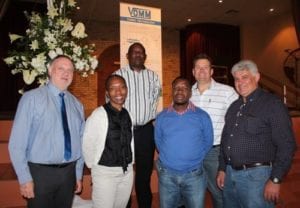The IMESA Northern Provinces branch met on Friday, 30 August 2013, at the Lux Mundi Community Church in Garsfontein, Pretoria.
“The Northern Province’s AGM and branch seminar was well attended by 71 guests and has, once again, proven to be a highlight on IMESA members’ annual agenda,” said Werner Bruhns, engineering consultant at the City of Tshwane and current chairman of IMESA’s Northern Provinces branch. “On behalf of the branch, we would like to express our gratitude to our sponsor for the day: VOMM (manufacturers of sludge drying technology) and TechsoSmart Solutions. We also like to thank all members who attended, especially our presenters who left the audience with interesting food for thought.” An impressive line-up of speakers delivered insightful presentations on the day. First on the agenda was Hilton Vorster, director traffic engineering at theCity of Tshwane’s Transport Department. Vorster provided worrying statistics about South African road safety and made a pledge to the audience to consider engineering interventions as one of the most critical elements of ensuring safer roads in South Africa. In his presentation ‘Designing for Safety – Important aspects to consider’, Vorsterhighlighted World Health Organisation (WHO) statistics, saying that although 88 countries have reduced their road traffic deaths, the global total of 1.24 million remains unacceptably high. More disconcerting is the fact that half of all recorded traffic deaths are pedestrians, cyclists and motorcyclists. “Progress has been made in high-income countries; however, the greatest need lies with low- and medium-income countries with small budgets and unacceptably high road death tolls remain,” explained Vorster. According to the WHO Global Status Report on Road Safety 2013 quoted by Vorster, Africa has the highest road traffic death rate of all continents, mainly as a result of rapid motorisation. “If you look at road deaths in Africa, South Africa is not doing well; we are the second highest killer of people in Africa, with 33 fatalities per 100 000 –only slightly lower than Nigeria”.Vorster emphasised that traffic engineers should make allowances that help tocompensate for human error. “Roads and roadsides must be built in such a way that their physical characteristics minimise potential harmful consequences to all,” was one of his central messages.
The presentation that followedVorster’s was given by Bavusile Ramekane from the same municipal department in the City of Tshwane. Ramekane is deputy director oftraffic engineering and gave a historical perspective on the usage and uptake of non-motorised transport (NMT) in the city. Ramekane provided information about Tshwane’s Shova Kalula project, a partnership between the city, the national Department of Transport (DOT) and the Gauteng Department of Roads and Transport (GDRT). The programme comprises the provision of bicycles by the DOT and the GDRT, while the City of Tshwane provides infrastructure and training. The third presentation was delivered by former IMESA president Moses Maliba on the training of candidates for registration as professionals in municipal engineering. Maliba highlighted the several challenges associated with the registration of professional engineers and,from IMESA’s perspective, provided guidance on the professional registration process. Other interesting presentations included that of Louis Marais and Lizette Retief, consultants from TechsoSmart Solutions, about a needs analysis of the Matroosberg and Garsfontein roads. The presentation highlighted how technological innovation could enhance traffic use modelling patterns. Dr Jeremy Gibberd, prominent environmental and green building researcher at the CSIR, presented a presentation on green building by-laws at the City of Tshwane. According to Gibberd,it is critical for city engineers to create cooler micro-climates through infrastructureby designing cooler cities, without using more energy. He shared some of the City of Tshwane’s green building by-laws, followed by examples of innovations that can used to achieve environmentally sound buildings, including water-neutral buildings. Other presentations included that of Dikgole Seroka, managing director of Seroka Consulting Engineers and Project Managers,about support to Rapid Response Units at water service authorities. Moses Malibagave a second presentation on IMESA’sinfrastructure management system (IIMS), which was followed by a presentation by VOMM South Africa’s managing director, Battista Errera, who focused on municipal sludge management and prevailing trends in the EU. In high spirits, the chairman closed off the presentations with a lucky draw, after which the IMESA AGM was held. “All presentations have been of outstanding quality, and we hope that branch members will take some of the concepts into their workplace to continue striving for excellence in municipal engineering,” Bruhns concluded.







